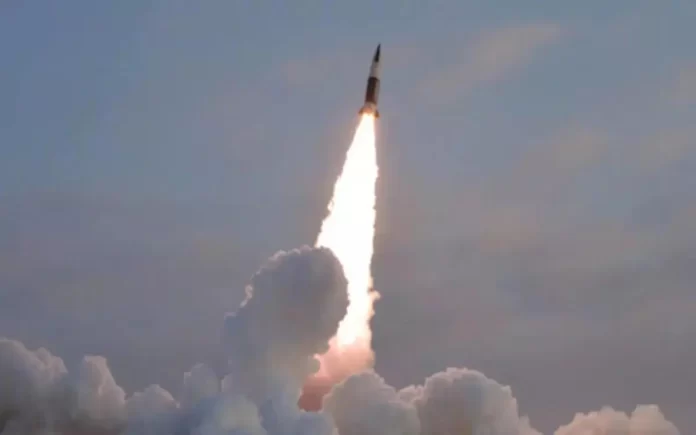Seoul: North Korea conducted a suspected test of an intermediate-range ballistic missile directed towards waters off its eastern coast on Tuesday, according to South Korea’s military, demonstrating its ongoing efforts to bolster its weaponry capable of targeting distant U.S. locations in the Pacific.
The Joint Chiefs of Staff in South Korea announced that the missile was launched from an area near North Korea’s capital, Pyongyang, and traveled approximately 600 kilometers (372 miles) before descending into the sea between the Korean Peninsula and Japan. While specific flight details were not immediately available, such as whether the missile was launched at full capacity or incorporated new technologies, this launch signifies North Korea’s continued advancement in missile capabilities.
Providing further insight, Japan’s Defense Ministry reported that the missile traveled about 650 kilometers (403 miles) and reached a maximum altitude of 100 kilometers (62 miles) before landing outside of Japan’s exclusive economic zone. However, Japan did not immediately classify the missile as intermediate-range or otherwise.
Last month, North Korea announced the testing of a solid-fuel engine for its new intermediate-range hypersonic missile, which, if successfully developed, could pose a threat to the U.S. Pacific military base in Guam and potentially beyond.
Also Read: India’s Path to Economic Competition with China Relies on Manufacturing, Says Jaishankar
This event marks North Korea’s first known missile launch since March 18, when North Korean leader Kim Jong Un oversaw a live-fire exercise involving artillery systems aimed at South Korea’s capital.
While Japan’s coast guard confirmed that the missile had landed, caution was advised for vessels navigating the area. Japanese Prime Minister Fumio Kishida expressed concern over North Korea’s frequent missile launches, emphasizing their threat not only to Japan but to regional and international security.
Tensions in the region have escalated since 2022, with Kim leveraging global distractions such as Russia’s invasion of Ukraine to accelerate missile and weapons testing. In response, the United States and South Korea have intensified joint training exercises, including trilateral drills involving Japan, and fortified deterrence strategies centered around key U.S. assets.
Amidst an election year in the United States and South Korea, there are apprehensions that North Korea may escalate pressure through further provocations.
Following the solid-fuel IRBM engine test on March 19, Kim highlighted the strategic significance of such weapons, positioning them as equally vital as intercontinental ballistic missiles aimed at the U.S. mainland.
In recent years, North Korea has prioritized the development of weapons equipped with solid propellants, which offer mobility, concealment, and quicker launch capabilities compared to liquid-propellant missiles.
Kim has also pledged to acquire hypersonic missiles capable of evading adversaries’ missile defense systems. Additionally, North Korea has tested cruise missiles and “super-large” multiple rocket launchers targeting the Seoul metropolitan area this year.
The latest missile launch comes after North Korea reiterated its intention to deploy several reconnaissance satellites this year. Despite no imminent signs of a satellite launch at North Korea’s main facility, South Korea’s military remains vigilant.
Kim regards satellites as essential for monitoring U.S. and South Korean military activities, thereby enhancing the threat posed by North Korea’s nuclear-capable missiles. Notably, North Korea successfully launched a military spy satellite into orbit for the first time last November.



